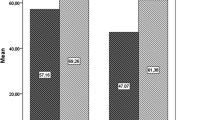Summary
In 26 patients undergoing operation for nasal obstruction, nasal and oral peak expiratory and inspiratory flow rates were measured preoperatively and 1 month postoperatively. Peak expiratory and inspiratory flow nasal patency indices were calculated from the ratio between the nasal and oral peak flow rates. Postoperatively, these indices were significantly increased for the total nose and for the preoperatively worse nasal cavity. No significant change was observed for the oral peak flow rates. A significant preoperative difference in nasal patency between the two nasal cavities was eliminated by surgery, as the postoperative peak flow of each nasal cavity reached 80% of the peak flow of the total nose on expiration and close to 50% on inspiration. A good correspondence between the subjective improvement of nasal patency and the increase in peak expiratory and inspiratory flow nasal patency indices was observed for the total nose. These findings show that peak flow nasal patency indices give valuable information pre- and post-operatively in patients undergoing nasal surgery and that the method is simple and easy to perform.
Similar content being viewed by others
References
Broms P (1980) Rhinomanometry. Thesis, Malmö
Davies HJ (1978) Measurement of nasal patency using a vitalograph. Clin Allergy 8:517–523
Frølund L, Madsen F, Mygind N, Nielsen NH, Svendsen UG, Weeke B (1987) Comparison between different techniques for measuring nasal patency in a group of unselected patients. Acta Otolaryngol (Stockh) 104:175–179
Jessen M, Malm L (1984) The importance of nasal airway resistance and nasal symptoms in the selection of patients for septoplasty. Rhinology 22:157–164
Jones AS, Lancer JM (1987) Rhinomanometry. Clin Otolaryngol 12:233–236
Larsen K, Oxhøj H (1988) Spirometric forced volume measurements in the assessment of nasal patency after septoplasty: a prospective clinical study. Rhinology 26:203–208
McCaffrey TV, Kern EB (1979) Clinical evaluation of nasal obstruction. Arch Otolaryngol 105:542–545
Munch EP, Weeke B, Johansson SÅ (1982) The effect of budesonide on nasal allergen challenge in patients with seasonal rhinitis and on nasal peak flow in healthy volunteers. Eur J Respir Dis 63 [Suppl 122]:176–184
Ogura JH, Harvey JE (1971) Nasopulmonary mechanics: experimental evidence of the influence of the upper airway upon the lower. Acta Otolaryngol (Stockh) 71:123–132
Taylor G, MacNeil AR, Freed DLJ (1973) Assessing the degree of nasal patency by measuring peak expiratory flow rate through the nose. J Allergy Clin Immunol 52:193–198
Wihl JA, Mahn L (1987) Rhinomanometry and nasal peak expiratory and inspiratory flow rate. Ann Allergy 61:50–55
Youlten LJF (1980) The peak nasal inspiratory flow meter: a new instrument for the assessment of the response to immunotherapy in seasonal allergic rhinitis. Allergol Immunopathol 8:344
Author information
Authors and Affiliations
Rights and permissions
About this article
Cite this article
Larsen, K., Oxhøj, H., Grøntved, A. et al. Peak flow nasal patency indices in patients operated for nasal obstruction. Eur Arch Otorhinolaryngol 248, 21–24 (1990). https://doi.org/10.1007/BF00634776
Received:
Accepted:
Issue Date:
DOI: https://doi.org/10.1007/BF00634776




